Sometimes a capability or technology comes along that seems like it should be easy to explain, but really isn’t — at least not without providing an in-person, first-person experience. It was difficult before when comparing polarized vs non-polarized eye pro, and it’s more so the the case now with Revision Military’s “I-Vis” technology for shooting glasses. I-Vis glasses might look like just the latest tactical sunglasses du jour, but there’s a lot of high-tech stuff going on in those lenses. It’s a lens technology that provides significantly increased contrast without losing detail.
That’s a much bigger deal than you might think.
Higher contrast with detail retention is something that even the higher end eye-pro (including Revision’s own) has previously been unable to do. Increasing contrast (or polarizing) a lens has previously by necessity meant blocking some of the light allowed through a lens. This results in a degradation of Gamut Expansion, which is the number of colors an individual can see.
That is no longer the case.
I-Vis Lens Technology
David Reeder
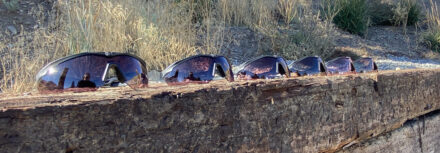
This article originally ran in October, 2022. It has been updated with additional information and imagery and republished.
We’ll have to get a little bit into color science to explain Gamut Expansion and how it affects your shooting and perception, but the BLUF is this:
It is now possible to injection mold a ballistic lens that delivers markedly (measurably) superior contrast without the previously-necessary reduction in detail.
As Revision explains it, I-Vis will “…expand chroma and enhance the number of colors the user can see.”
The tech is in the dye formulation process.
It is much easier to see it through the lenses than to grasp it based on a few hundred words, but here’s a basic rundown.
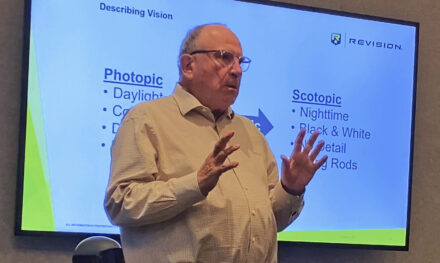
There are three types of vision: Photopic, Scotopic, and Mesoptic. Photopic (which uses cones) =color, daylight, and detail. Scotopic (which uses rods) = nighttime, black & white, lack of detail. Traditional tinted shooting lenses increase contrast by moving color reception from photopic toward scotopic, with a corresponding loss of detail.
Color Neutral Lens Tech
The first things to understand are, 1) light is information to the brain, and 2) contrast = differentiation.
I-Vis improves both of those things. It does so by increasing ocular resolution by an estimated 130% or more. It does this with just a marginal reduction in sharpness when compared to a good clear lens and without the significant degradation of true color caused by traditional tinted lenses. Although we haven’t (yet) seen independent testing to confirm that exact number, an initial field expedient trial by media members, some competitive shooters, and (unofficially) some specialized military personnel does seem to corroborate the claim. The eyes of every individual are different, but most people will see a marked difference in contrast and detail using I-Vis vs. traditional tinted contrast eye protection.
Traditional shooting/ballistic glasses typically use a monochromatic lens tint that enhances contrast, often significantly so. However, this reduces the Gamut of Expansion and color accuracy and also increases eye fatigue. To combat this, users engaging in “color critical” tasks use something like a basic smoke-tinted lens that offers no performance benefit other than light reduction.
Dr. Richard Colo, OD, explains in part:
“In terms of performance, all shooting glasses have been predicated on what I like to call the wow factor. For decades, people selling glasses for shooting would increase contrast so that we wound having the tint of the month…increase contrast, increase contrast, increase contrast. That became a kind of benchmark in terms of how good a shooting glass lens was. The problem with that is, as you increase the contrast, you reduce the amount of light coming in. As you reduce the amount of light coming in, you’re shifting from photopic detail toward scotopic black and white.”
I-Vis glasses are color neutral. This enhances color accuracy, reduces eye fatigue, increases depth perception, and provides greater visual detail.
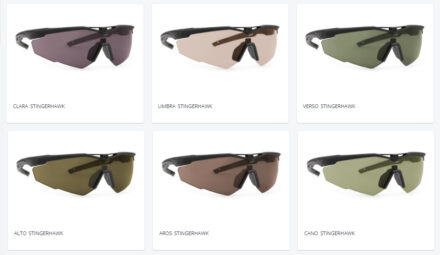
Eyes make only two movements. One is a “smooth pursuit” movement. The other is “saccadic” movement. Smooth pursuit, which uses cones, is how we pull the trigger. Saccadic, which uses rods, is how we go from one spot to the other – and it’s a thousand times as fast as smooth pursuit. I-Vis lens technology improves contrast (i.e. differentiation) without negatively impacting either. This increases visual performance.
Filtering light
Let’s break it down substantially more Barney-style: I-Vis lenses add more colors to your crayon box.
With more crayons you can draw (i.e. see) with better resolution and depth perception. It’s not that the red object you see becomes “more redder”, it’s that it becomes more of that object’s actual, specific red hue. This effectively reveals things — admittedly sometimes smaller, seemingly inconsequential things — you would otherwise not have seen. Think digital photograph vs. posterized clip art, albeit not always as immediately drastic.
From a performance perspective, particularly in a tactical or other life-or-limb situation, little inconsequential details are often anything but.
Increased contrast without loss of detail allows for accurate recognition of colors. Accurate recognition of colors ensures depth performance and promotes visual comfort.
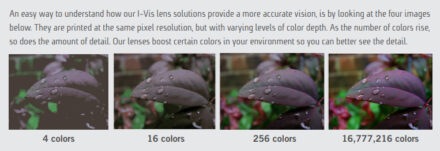
Image comparison courtesy of Revision Military.
Confident Perspective
In addition to the obvious benefit of improved perception, target acquisition, and the like, increased contrast without corresponding loss of detail improves confidence. Dr. Colo, who also has a degree in psychology, makes a particular point of this in the context of shotgun sports.
“Take for example an average individual in the field wearing a clear lens. That person is out shooting clays. The pupil constricts and depth of field increases. The constricted pupil restricts the blur circle at the back of the eye, increasing the depth of field, and everything is clear. Going on down a few stations, though, now your pupil dilates. This puts a bit of a fuzzy edge around the target. It’s not the fuzzy edge that might be a problem problem, it’s the potential effect of that fuzzy edge on the shooter’s confidence-doubt that could become the problem.”
“Contrast sells glasses. Detail hits (or breaks) targets.” Dr. Richard Colo
This sort of increased confidence is obviously just as applicable (and potentially far more significant) to someone trying to pick up and identify a moving target through a scope, or notice minute changes in the soil that might indicate an IED, or the presence of a camouflaged threat.

Sid Mitchell of Revision Military (who wears prescription glasses) explaining how I-Vis works, and how it might work to make Rx versions of the lenses.
Environmentally Specific.
Well, ~ish.
There are six tints of I-Vis available, each developed after an extensive theater-specific study of potential AO color palettes using global data from the National Oceanic and Atmospheric Administration (NOAA).
This provides for five individual tints designed to increase contrast and elevate color recognition in the prevalent terrain of different geographic regions, plus a “general purpose” tint that functions extremely well across the board (if not to the extent of the more specialized lenses).

It’s hard to adequately and accurately demonstrate how I-Vis impacts color perception, but here’s a crude attempt. This gif begins with Verso lenses in front of the camera, then shows what it looks like without them (and back).
The I-Vis lens line includes:
• Verso
The most technically complex I-Vis lens, Verso designed for the widest range of environments and settings. This is the general purpose lens one would want if only able to buy one pair. (Visible Light Transmittance/VLT: 19%*)
• Aros
Aros is intended to enhance colors found in typical desert environments. It brings out differences between similar shades of brown, tan, yellow, and orange colors while making man-made structures and objects stand out. (VLT: 12%*)
• Cano
Cano was developed to provide color definition environments dominated by greens, browns, and grays (typified in lush foliage). Cano lenses maximize visual light transmission because they’re designed for densely forested areas with a canopy and shaded terrain. Man-made structures will stand out, as will differences (or changes) in the foreground landscape. (VLT: 37%*)

This is a look at the same ravine as above, this time using Cano lenses. With, then without, then with again. Use of an animated gif on an electronic screen is necessarily crude – apologies for that.
• Alto
Alto lenses are suited to dry, high-altitude environments dominated by grays, tans, and blues (such as the terrain found in northern Afghanistan). (VLT: 12%*)
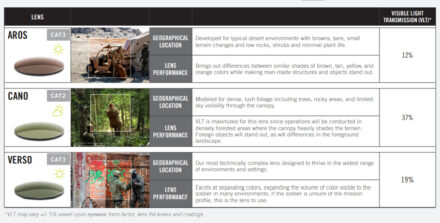
• Clara
Clara lenses were modeled for use in northern Europe, Scandinavia, and the Baltics, and Poland. They’re designed to bring out color definition and contrast in brightly lit areas of white, gray, and blue. Think snowy wooded areas, rocks, mountains, and areas with undulating snowpack. (VLT: 12%*)
• Umbra
Much like Clara, the Umbra dye formulation is intended to improve color contrast in overcast, snow-prominent areas dominated by whites and greys (snowy, rocky areas and mountains). (VLT: 48%*)
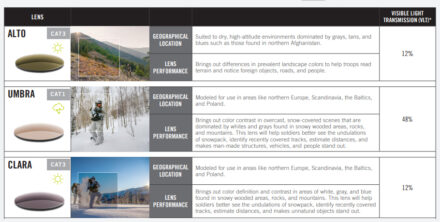
Polarized vs non-polarized is no longer the main choice; now it’s a matter of appropriately selecting the correct environmental lens from the Revision Eyewear i-Vis line.
*VLT may vary +/- 5% based upon eyewear form factor, lens thickness and coatings.
Polarized vs Non-Polarized
To better grasp why i-Vis lens tech is significant, it might be helpful to understand just a little about how polarized vs non-polarized lenses work. Polarized sunglasses provide a sharper image than non-polarized sunglasses. A polarized lens seems to call out better detail than non-polarized lenses while simultaneously doing their main job – cutting the glare of bright light, increasing visual clarity, and reducing eye strain.
Reflected light (light waves bounced off a horizontal surface like water, sand, snow, and pavement) is often worse than bright sunlight, even when direct. That reflective surface glare is where you wring the most advantage from polarized glasses (whether corrective, ballistic, and/or safety glasses) vs. regular sunglasses.
Polarized lenses are great. Many people (myself included) prefer them to non-polarized ones, particularly when on the range, driving, or doing something else outdoors. Unfortunately, the anti-reflective coating used on a polarized sunglass lens to achieve glare mitigation does so by filtering out certain light waves. I won’t pretend to understand all the science, but as I understand it, that anti-glare lens coating is designed to block horizontal light (i.e., shimmer, dazzle, etc.) in particular. In simplest terms, this means it acts like slats on a window blind, blocking out horizontal rays in particular.
Because some light is blocked, however, some information is lost. That’s why polarized shades aren’t always the best choice for wear on an overcast day, driving in potentially icy conditions, or just looking at digital screens (LCD screen, phone or tablet, etc.). A non-polarized lens doesn’t block glare as well but does a better job of allowing you to see your environment more how it really is. Non-polarized glasses can also provide UV protection, of course, and that’s all anyone needs many times.
Revision’s i-Vis glasses provide many of the advantages of polarized options, vis-a-vis horizontal light waves, contrast, etc., without the reduction of information that comes from polarized light. My Speed Demons (the metal frame i-Vis option) do a great job blocking reflection and providing contrast, but I don’t know how (or if) they protect UV light/UV rays. I’ll have to find that out.
I-Vis EyePro Features
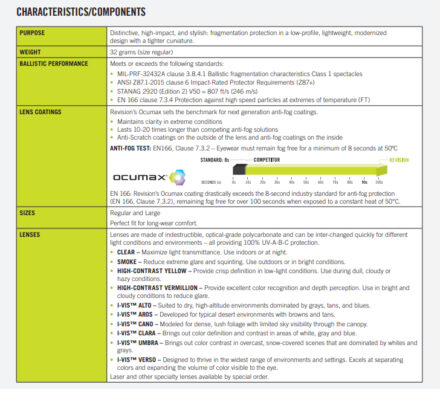
Prior to i-Vis, the most common eye pro comparisons boiled down to ballistic vs impact protective, and polarized vs non-polarized. This lens technology has greatly changed those limitations.
Options Available
Initial styles of I-Vis will include Stingerhawk spectacles and Snowhawk goggles. There will be other styles and models in the future however, all focusing on what Revision’s Sid Mitchell views as the necessary trifecta of modern eye protection: protection, performance, and style.*
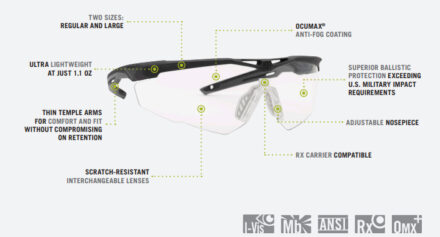
The Stingerhawk spectacle system will be available in I-Vis.
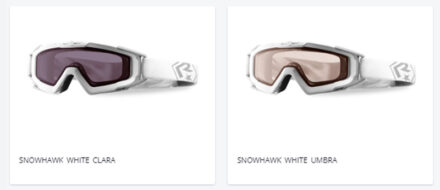
So will Snowhawk goggles.
*Style might seem trivial in the context of form vs. function, but it’s not. Not when style and aesthetics directly impact the use of eye pro off the battlefield – which it does. This was true before, when debating the relative merits of polarized vs non-polarized lenses, and it remains true now that i-Vis has entered the chat.
Learn more at RevisionMilitary.com.
DRW

Tags: DR Sends


Every pair of Revision lenses I own have developed a glazing over or frosted appearance in the lenses themself. This defect appears around the edges of the lenses.
And no, I have not contacted Revision Military. Quite honestly I tire of products I purchase becoming defective. Then having to go to the effort, the expense, the hassle to deal with the company/manufacturer.
I thought this was par for the course with any ballistics with a tint. Caused by exposure to UV I thought. Certainly has been the case with every set of Oakley MIGs I’ve owned
I have definitely had this with both Oakley and Smith ballistic options.
Isn’t it expected glasses worn outside will be exposed to UV, and maybe accounted for in the making of an expensive lens?